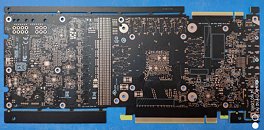- Joined
- Oct 9, 2007
- Messages
- 47,878 (7.38/day)
- Location
- Dublin, Ireland
| System Name | RBMK-1000 |
|---|---|
| Processor | AMD Ryzen 7 5700G |
| Motherboard | Gigabyte B550 AORUS Elite V2 |
| Cooling | DeepCool Gammax L240 V2 |
| Memory | 2x 16GB DDR4-3200 |
| Video Card(s) | Galax RTX 4070 Ti EX |
| Storage | Samsung 990 1TB |
| Display(s) | BenQ 1440p 60 Hz 27-inch |
| Case | Corsair Carbide 100R |
| Audio Device(s) | ASUS SupremeFX S1220A |
| Power Supply | Cooler Master MWE Gold 650W |
| Mouse | ASUS ROG Strix Impact |
| Keyboard | Gamdias Hermes E2 |
| Software | Windows 11 Pro |
Here are some of the first pictures of the bare printed circuit board (PCB) of NVIDIA's upcoming GeForce GTX 1180 graphics card (dubbed PG180), referred to by the person who originally posted them as "GTX 2080" (it seems the jury is still out on the nomenclature). The PCB looks hot from the press, with its SMT points and vias still exposed. The GT104 GPU traces hint at a package that's about the size of a GP104 or its precessors. It's wired to eight memory chips on three sides, confirming a 256-bit wide memory bus. Display outputs appear flexible, for either 2x DisplayPort + 2x HDMI, or 3x DisplayPort + 1x HDMI configurations.
The VRM setup is surprisingly powerful for a card that's supposed to succeed the ~180W GeForce GTX 1080, which can make do with a single 8-pin PCIe power input. The card draws power from a combination of 6-pin and 8-pin PCIe power connectors. There is a purportedly 10-phase VCore side, which in all likelihood is a 5-phase setup with "dumb" phase-doubling; and similarly, a 2-phase memory power (which could again be doubled single-phase). The SLI-HB fingers also make way. There's a new connector that looks like a single SLI finger and an NVLink finger arranged side-by-side. NVIDIA still hasn't given up on multi-GPU. NVLink is a very broad interconnect, in terms of bandwidth. NVIDIA probably needs that for multi-GPU setups to work with not just high resolutions (4K, 5K, or even 8K), but also higher bit-depth, higher refresh-rates, HDR, and other exotic data. The reverse side doesn't have much action other than traces for the VRM controllers, phase doublers, and an unusually large bank of SMT capacitors (the kind seen on AMD PCBs with MCM GPUs).


View at TechPowerUp Main Site
The VRM setup is surprisingly powerful for a card that's supposed to succeed the ~180W GeForce GTX 1080, which can make do with a single 8-pin PCIe power input. The card draws power from a combination of 6-pin and 8-pin PCIe power connectors. There is a purportedly 10-phase VCore side, which in all likelihood is a 5-phase setup with "dumb" phase-doubling; and similarly, a 2-phase memory power (which could again be doubled single-phase). The SLI-HB fingers also make way. There's a new connector that looks like a single SLI finger and an NVLink finger arranged side-by-side. NVIDIA still hasn't given up on multi-GPU. NVLink is a very broad interconnect, in terms of bandwidth. NVIDIA probably needs that for multi-GPU setups to work with not just high resolutions (4K, 5K, or even 8K), but also higher bit-depth, higher refresh-rates, HDR, and other exotic data. The reverse side doesn't have much action other than traces for the VRM controllers, phase doublers, and an unusually large bank of SMT capacitors (the kind seen on AMD PCBs with MCM GPUs).


View at TechPowerUp Main Site





 etc These are very rare actually.
etc These are very rare actually.
